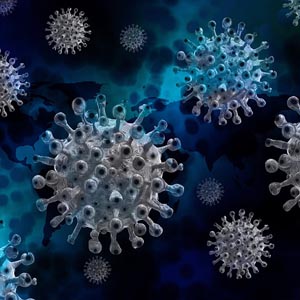Has COVID-19 lowered physical activity practice while boosting online searches for professional exercise information?

Accepted: 2 May 2023
HTML: 3
All claims expressed in this article are solely those of the authors and do not necessarily represent those of their affiliated organizations, or those of the publisher, the editors and the reviewers. Any product that may be evaluated in this article or claim that may be made by its manufacturer is not guaranteed or endorsed by the publisher.
COVID-19 is an infectious and contagious disease, caused by the SARS-CoV-2 virus. Due to the rapid spreading of the virus and its lethal consequences, the WHO declared a pandemic. One of the main strategies to treat and prevent the spreading was the stay home safe, a social isolation situation that was accompanied by the closing of fitness gyms, city parks and facilities proper to exercise. This context promoted an increase in home fitness programs and in the search for information online regarding exercise and health. So, the objective of this study was to understand the effects of the pandemic on physical activity behavior and online information search regarding exercise programs. Data collection was through a google forms questionnaire, all procedures were approved by the University ethics committee and we collected data from 1065 participants. Our results showed that the participants main behavior was maintained, 80.7% of our sample were active before the pandemic and only 9.7% of this group stopped being active. On the other hand we registered 7% of participants that started exercise after the pandemic installation. Information about exercise was searched outside social media by 49.6% of the participants with 32.5% using social media. 56.1% would look only for professional advice, interestingly 11.4% of the participants were active without any kind of advice. We concluded that Covid-19 pandemic installation affected negatively the population physical activity behavior and increased awareness about the importance of exercise as a health strategy.
World Health Organization. WHO Director-General’s opening remarks at the media briefing on COVID-19. [https://www.who.int/dg/speeches/ detail/whodirector-general-s-opening-remarks-at-the-media-briefing-on-covid-19. 11-March-2020] Accessed in January of 2021.
Alsharji KE. Anxiety and depression during the COVID-19 pandemic in Kuwait: the importance of physical activity. Middle East Current Psychiatry. 2020;27:60. DOI: https://doi.org/10.1186/s43045-020-00065-6
The European Health Report. World Health Organization: https://apps.who.int › handle › 9789289057547-eng. 2021. Chapter 3. Impacts of the COVID-19 pandemic on population health.
Panayotov K. Covid-19 and current problems in EU Health Policy. J Healthc. 2021; 4:28-32.
Luan X, Tian X, Zhang H, Huang R, Li N, Chen P, Wang R. Exercise as a prescription for patients with various diseases. J Sport Health Sci. 2019 Sep;8(5):422-441. Epub 2019 Apr 18. PMID: 31534817; PMCID: PMC6742679. DOI: https://doi.org/10.1016/j.jshs.2019.04.002
Bonnar-Kidd KK, Black DR, Mattson M, Coster D. Online physical activity information: will typical users find quality information? Health Commun. 2009 Mar;24(2):165-75. PMID: 19280460. DOI: https://doi.org/10.1080/10410230802676763
Wu Y, Ho W, Huang Y, Jin DY, Li S, Liu SL, Liu X, Qiu J, Sang Y, Wang Q, Yuen KY, Zheng ZM. SARS-CoV-2 is an appropriate name for the new coronavirus. Lancet. 2020 Mar 21;395(10228):949-950. Epub 2020 Mar 6. PMID: 32151324; PMCID: PMC7133598. DOI: https://doi.org/10.1016/S0140-6736(20)30557-2
American College of Sports Medicine (ACSM). Staying active during the coronavirus pandemic. [https://www.exerciseismedicine.org/assets/page _documents/EIM_Rx%20for%20Health%20Staying%20Active%20During%20Coronavirus%20Pandemic.pdf] Accessed in 2020.
Gonzalez A, Abrigo J, Achiardi O, Simon F, Cabello-Verrugio C. Intensive care unit-acquired weakness: A review from molecular mechanisms to its impact in COVID-2019. Eur J Transl Myol. 2022 Aug 26;32(3):10511. PMID: 36036350; PMCID: PMC9580540. DOI: https://doi.org/10.4081/ejtm.2022.10511
Gonzalez A, Abrigo J, Achiardi O, Simon F, Cabello-Verrugio C. Intensive care unit-acquired weakness: A review from molecular mechanisms to its impact in COVID-2019. Eur J Transl Myol. 2022 Aug 26;32(3):10511. PMID: 36036350; PMCID: PMC9580540. DOI: https://doi.org/10.4081/ejtm.2022.10511
Dunton GF, Wang SD, Do B, Courtney J. Early effects of the COVID-19 pandemic on physical activity locations and behaviors in adults living in the United States. Prev Med Rep. 2020 Dec;20:101241. Epub 2020 Nov 5. PMID: 33173751; PMCID: PMC7644187. DOI: https://doi.org/10.1016/j.pmedr.2020.101241
Amini H, Isanejad A, Chamani N, Movahedi-Fard F, Salimi F, Moezi M, Habibi S. Physical activity during COVID-19 pandemic in the Iranian population: A brief report. Heliyon. 2020 Nov;6(11):e05411. Epub 2020 Nov 2. PMID: 33163638; PMCID: PMC7605807. DOI: https://doi.org/10.1016/j.heliyon.2020.e05411
López-Viñas L, Vega-Villar J, Rocío-Martín E, García-García P, De La Rosa Santiago E, Galván-Román JM, Wix-Ramos R. Diaphragm impairment in patients admitted for severe COVID-19. Eur J Transl Myol. 2022 Jun 21;32(2):10460. PMID: 35727218; PMCID: PMC9295177. DOI: https://doi.org/10.4081/ejtm.2022.10460
Nieman DC, Wentz LM. The compelling link between physical activity and the body's defense system. J Sport Health Sci. 2019 May;8(3):201-217. Epub 2018 Nov 16. PMID: 31193280; PMCID: PMC6523821. DOI: https://doi.org/10.1016/j.jshs.2018.09.009
Fisher G, Schwartz DD, Quindry J, Barberio MD, Foster EB, Jones KW, Pascoe DD. Lymphocyte enzymatic antioxidant responses to oxidative stress following high-intensity interval exercise. J Appl Physiol (1985). 2011 Mar;110(3):730-7. Epub 2010 Dec 2. PMID: 21127208. DOI: https://doi.org/10.1152/japplphysiol.00575.2010
Zenko Z, Willis EA, White DA. Proportion of Adults Meeting the 2018 Physical Activity Guidelines for Americans According to Accelerometers. Front Public Health. 2019 Jun 7;7:135. PMID: 31231627; PMCID: PMC6566056. DOI: https://doi.org/10.3389/fpubh.2019.00135
Gottlieb M, Dyer S. Information and Disinformation: Social Media in the COVID-19 Crisis. Acad Emerg Med. 2020 Jul;27(7):640-641. Epub 2020 Jun 24. PMID: 32474977; PMCID: PMC7300599. DOI: https://doi.org/10.1111/acem.14036
Lv Z, Lv S. Clinical characteristics and analysis of risk factors for disease progression of COVID-19: A retrospective Cohort Study. Int J Biol Sci. 2021 Jan 1;17(1):1-7. PMID: 33390828; PMCID: PMC7757033. DOI: https://doi.org/10.7150/ijbs.50654
Jordan RE, Adab P, Cheng KK. Covid-19: risk factors for severe disease and death. BMJ. 2020 Mar 26;368:m1198. PMID: 32217618. DOI: https://doi.org/10.1136/bmj.m1198
Jordan JJ, Yoeli E, Rand DG. Don't get it or don't spread it: comparing self-interested versus prosocial motivations for COVID-19 prevention behaviors. Sci Rep. 2021 Oct 12;11(1):20222. PMID: 34642341; PMCID: PMC8511002. DOI: https://doi.org/10.1038/s41598-021-97617-5
Copyright (c) 2023 the Author(s)

This work is licensed under a Creative Commons Attribution-NonCommercial 4.0 International License.
PAGEPress has chosen to apply the Creative Commons Attribution NonCommercial 4.0 International License (CC BY-NC 4.0) to all manuscripts to be published.


 https://doi.org/10.4081/ejtm.2023.11343
https://doi.org/10.4081/ejtm.2023.11343



